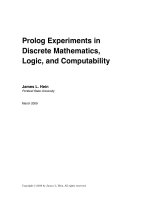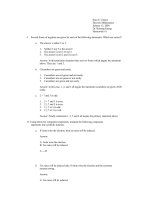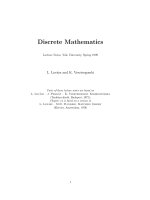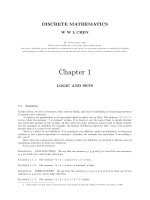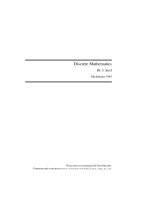discrete mathematics tutorial
Bạn đang xem bản rút gọn của tài liệu. Xem và tải ngay bản đầy đủ của tài liệu tại đây (2.08 MB, 104 trang )
Discrete Mathematics
About the Tutorial
Discrete Mathematics is a branch of mathematics involving discrete elements that uses
algebra and arithmetic. It is increasingly being applied in the practical fields of
mathematics and computer science. It is a very good tool for improving reasoning and
problem-solving capabilities.
This tutorial explains the fundamental concepts of Sets, Relations and Functions,
Mathematical Logic, Group theory, Counting Theory, Probability, Mathematical Induction
and Recurrence Relations, Graph Theory, Trees and Boolean Algebra.
Audience
This tutorial has been prepared for students pursuing a degree in any field of computer
science and mathematics. It endeavors to help students grasp the essential concepts of
discrete mathematics.
Prerequisites
This tutorial has an ample amount of both theory and mathematics. The readers are
expected to have a reasonably good understanding of elementary algebra and arithmetic .
Copyright & Disclaimer
Copyright 2014 by Tutorials Point (I) Pvt. Ltd.
All the content and graphics published in this e-book are the property of Tutorials Point (I)
Pvt. Ltd. The user of this e-book is prohibited to reuse, retain, copy, distribute or republish
any contents or a part of contents of this e-book in any manner without writt en consent
of the publisher.
We strive to update the contents of our website and tutorials as timely and as precisely as
possible, however, the contents may contain inaccuracies or errors. Tutorials Point (I) Pvt.
Ltd. provides no guarantee regarding the accuracy, timeliness or completeness of our
website or its contents including this tutorial. If you discover any errors on our website or
in this tutorial, please notify us at
i
Discrete Mathematics
Table of Contents
About the Tutorial .............................................................................................................................................................i
Audience..............................................................................................................................................................................i
Prerequisites .......................................................................................................................................................................i
Copyright & Disclaimer .....................................................................................................................................................i
Table of Contents ............................................................................................................................................................. ii
1.
Discrete Mathematics – Introduction ..........................................................................................................................1
Topics in Discrete Mathematics .....................................................................................................................................1
PART 1: SETS, RELATIONS, AND FUNCTIONS............................................................... 2
2.
Sets ......................................................................................................................................................................................3
Set – Definition..................................................................................................................................................................3
Representation of a Set...................................................................................................................................................3
Cardinality of a Set ...........................................................................................................................................................4
Types of Sets ......................................................................................................................................................................4
Venn Diagrams ..................................................................................................................................................................6
Set Operations...................................................................................................................................................................7
Power Set ...........................................................................................................................................................................8
Partitioning of a Set ..........................................................................................................................................................9
3.
Relations ......................................................................................................................................................................... 10
Definition and Properties ............................................................................................................................................. 10
Domain and Range......................................................................................................................................................... 10
Representation of Relations using Graph.................................................................................................................. 10
Types of Relations.......................................................................................................................................................... 11
4.
Functions......................................................................................................................................................................... 12
Function – Definition..................................................................................................................................................... 12
Injective / One-to-one function................................................................................................................................... 12
Surjective / Onto function ............................................................................................................................................ 12
Bijective / One-to-one Correspondent....................................................................................................................... 12
Composition of Functions............................................................................................................................................. 13
PART 2: MATHEMATICAL LOGIC............................................................................ 14
5.
Propositional Logic........................................................................................................................................................ 15
Prepositional Logic – Definition................................................................................................................................... 15
Connectives..................................................................................................................................................................... 15
Tautologies...................................................................................................................................................................... 17
Contradictions ................................................................................................................................................................ 17
Contingency .................................................................................................................................................................... 17
Propositional Equivalences .......................................................................................................................................... 18
Inverse, Converse, and Contra-positive..................................................................................................................... 18
Duality Principle ............................................................................................................................................................. 19
Normal Forms ................................................................................................................................................................. 19
ii
Discrete Mathematics
6.
Predicate Logic............................................................................................................................................................... 20
Predicate Logic – Definition ......................................................................................................................................... 20
Well Formed Formula ................................................................................................................................................... 20
Quantifiers ...................................................................................................................................................................... 20
Nested Quantifiers......................................................................................................................................................... 21
7.
Rules of Inference ......................................................................................................................................................... 22
What are Rules of Inference for? ................................................................................................................................ 22
Addition ........................................................................................................................................................................... 22
Conjunction..................................................................................................................................................................... 22
Simplification.................................................................................................................................................................. 23
Modus Ponens ................................................................................................................................................................ 23
Modus Tollens ................................................................................................................................................................ 23
Disjunctive Syllogism ..................................................................................................................................................... 24
Hypothetical Syllogism.................................................................................................................................................. 24
Constructive Dilemma................................................................................................................................................... 24
Destructive Dilemma ..................................................................................................................................................... 25
PART 3: GROUP THEORY ..................................................................................... 26
8.
Operators and Postulates............................................................................................................................................ 27
Closure ............................................................................................................................................................................. 27
Associative Laws............................................................................................................................................................. 27
Commutative Laws ........................................................................................................................................................ 28
Distributive Laws............................................................................................................................................................ 28
Identity Element............................................................................................................................................................. 28
Inverse ............................................................................................................................................................................. 29
De Morgan’s Law ........................................................................................................................................................... 29
9.
Group Theory ................................................................................................................................................................. 30
Semigroup ....................................................................................................................................................................... 30
Monoid ............................................................................................................................................................................ 30
Group ............................................................................................................................................................................... 30
Abelian Group................................................................................................................................................................. 31
Cyclic Group and Subgroup .......................................................................................................................................... 31
Partially Ordered Set (POSET) ...................................................................................................................................... 32
Hasse Diagram................................................................................................................................................................ 32
Linearly Ordered Set...................................................................................................................................................... 33
Lattice............................................................................................................................................................................... 33
Properties of Lattices .................................................................................................................................................... 35
Dual of a Lattice.............................................................................................................................................................. 35
PART 4: COUNTING & PROBABILITY ....................................................................... 36
10. Counting Theory ............................................................................................................................................................ 37
The Rules of Sum and Product..................................................................................................................................... 37
Permutations .................................................................................................................................................................. 37
Combinations.................................................................................................................................................................. 39
Pascal's Identity.............................................................................................................................................................. 40
Pigeonhole Principle...................................................................................................................................................... 40
The Inclusion-Exclusion principle ................................................................................................................................ 41
iii
Discrete Mathematics
11. Probability ...................................................................................................................................................................... 42
Basic Concepts................................................................................................................................................................ 42
Probability Axioms ......................................................................................................................................................... 43
Properties of Probability............................................................................................................................................... 43
Conditional Probability ................................................................................................................................................. 44
Bayes' Theorem.............................................................................................................................................................. 45
PART 5: MATHEMATICAL INDUCTION & RECURRENCE RELATIONS ................................. 47
12. Mathematical Induction .............................................................................................................................................. 48
Definition......................................................................................................................................................................... 48
How to Do It.................................................................................................................................................................... 48
Strong Induction............................................................................................................................................................. 49
13. Recurrence Relation ..................................................................................................................................................... 50
Definition......................................................................................................................................................................... 50
Linear Recurrence Relations ........................................................................................................................................ 50
Particular Solutions........................................................................................................................................................ 52
Generating Functions .................................................................................................................................................... 53
PART 6: DISCRETE STRUCTURES............................................................................ 55
14. Graph and Graph Models ............................................................................................................................................ 56
What is a Graph?............................................................................................................................................................ 56
Types of Graphs.............................................................................................................................................................. 57
Representation of Graphs ............................................................................................................................................ 60
Planar vs. Non-planar graph ........................................................................................................................................ 62
Isomorphism ................................................................................................................................................................... 63
Homomorphism ............................................................................................................................................................. 63
Euler Graphs ................................................................................................................................................................... 63
Hamiltonian Graphs....................................................................................................................................................... 64
15. More on Graphs............................................................................................................................................................. 66
Graph Coloring ............................................................................................................................................................... 66
Graph Traversal .............................................................................................................................................................. 67
16. Introduction to Trees.................................................................................................................................................... 71
Tree and its Properties.................................................................................................................................................. 71
Centers and Bi-Centers of a Tree ................................................................................................................................ 71
Labeled Trees ................................................................................................................................................................. 74
Unlabeled trees.............................................................................................................................................................. 74
Rooted Tree .................................................................................................................................................................... 75
Binary Search Tree ......................................................................................................................................................... 76
17. Spanning Trees............................................................................................................................................................... 78
Minimum Spanning Tree .............................................................................................................................................. 79
Kruskal's Algorithm ........................................................................................................................................................ 79
Prim's Algorithm............................................................................................................................................................. 82
iv
Discrete Mathematics
PART 7: BOOLEAN ALGEBRA ................................................................................ 86
18. Boolean Expressions and Functions .......................................................................................................................... 87
Boolean Functions ......................................................................................................................................................... 87
Boolean Expressions...................................................................................................................................................... 87
Boolean Identities .......................................................................................................................................................... 87
Canonical Forms ............................................................................................................................................................. 88
Logic Gates ...................................................................................................................................................................... 90
19. Simplification of Boolean Functions ......................................................................................................................... 93
Simplification Using Algebraic Functions................................................................................................................... 93
Karnaugh Maps .............................................................................................................................................................. 94
Simplification Using K- map ......................................................................................................................................... 95
v
1. DISCRETE MATHEMATICS – INTRODUCTION
Discrete Mathematics
Mathematics can be broadly classified into two categories:
Continuous Mathematics
Discrete Mathematics
Continuous Mathematics is based upon continuous number line or the real numbers. It
is characterized by the fact that between any two numbers, there are almost always
an infinite set of numbers. For example, a function in continuous mathematics can be
plotted in a smooth curve without breaks.
Discrete Mathematics, on the other hand, involves distinct values; i.e. between any two
points, there are a countable number of points. For example, if we have a finite set of
objects, the function can be defined as a list of ordered pairs having these objects, and
can be presented as a complete list of those pairs.
Topics in Discrete Mathematics
Though there cannot be a definite number of branches of Discrete Mathematics, the
following topics are almost always covered in any study regarding this matter:
Sets, Relations and Functions
Mathematical Logic
Group theory
Counting Theory
Probability
Mathematical Induction and Recurrence Relations
Graph Theory
Trees
Boolean Algebra
1
Discrete Mathematics
Part 1: Sets, Relations, and Functions
2
2. SETS
Discrete Mathematics
German mathematician G. Cantor introduced the concept of sets. He had defined a set as
a collection of definite and distinguishable objects selected by the means of certain rules
or description.
Set theory forms the basis of several other fields of study like counting theory, relations,
graph theory and finite state machines. In this chapter, we will cover the different aspects
of Set Theory.
Set – Definition
A set is an unordered collection of different elements. A set can be written explicitly by
listing its elements using set bracket. If the order of the elements is changed or any
element of a set is repeated, it does not make any changes in the set.
Some Example of Sets
A set of all positive integers
A set of all the planets in the solar system
A set of all the states in India
A set of all the lowercase letters of the alphabet
Representation of a Set
Sets can be represented in two ways:
Roster or Tabular Form
Set Builder Notation
Roster or Tabular Form
The set is represented by listing all the elements comprising it. The elements are enclosed
within braces and separated by commas.
Example 1: Set of vowels in English alphabet, A = {a,e,i,o,u}
Example 2: Set of odd numbers less than 10, B = {1,3,5,7,9}
Set Builder Notation
The set is defined by specifying a property that elements of the set have in common. The
set is described as A = { x : p(x)}
Example 1: The set {a,e,i,o,u} is written as:
A = { x : x is a vowel in English alphabet}
3
Discrete Mathematics
Example 2: The set {1,3,5,7,9} is written as:
B = { x : 1≤x<10 and (x%2)=0}
If an element x is a member of any set S, it is denoted by x∈ S and if an element y is not
a member of set S, it is denoted by y ∉ S.
Example:
If S = {1, 1.2,1.7,2}, 1∈ S but 1.5 ∉S
Some Important Sets
N: the set of all natural numbers = {1, 2, 3, 4, .....}
Z: the set of all integers = {....., -3, -2, -1, 0, 1, 2, 3, .....}
Z+: the set of all positive integers
Q: the set of all rational numbers
R: the set of all real numbers
W: the set of all whole numbers
Cardinality of a Set
Cardinality of a set S, denoted by |S|, is the number of elements of the set. If a set has
an infinite number of elements, its cardinality is ∞.
Example:
|{1, 4, 3,5}| = 4, |{1, 2, 3,4,5,…}| = ∞
If there are two sets X and Y,
| X| = | Y | represents two sets X and Y that have the same cardinality, if there
exists a bijective function ‘f’ from X to Y.
| X| ≤ | Y | represents set X has cardinality less than or equal to the cardinality of
Y, if there exists an injective function ‘f’ from X to Y.
| X| < | Y | represents set X has cardinality less than the cardinality of Y , if there is
an injective function f, but no bijective function ‘f’ from X to Y.
If | X | ≤ | Y | and | X | ≤ | Y | then | X | = | Y |
Types of Sets
Sets can be classified into many types. Some of which are finite, infinite, subset, universal,
proper, singleton set, etc.
4
Discrete Mathematics
Finite Set
A set which contains a definite number of elements is called a finite set.
Example: S = {x | x ∈ N and 70 > x > 50}
Infinite Set
A set which contains infinite number of elements is called an infinite set.
Example: S = {x | x ∈ N and x > 10}
Subset
A set X is a subset of set Y (Written as X ⊆Y) if every element of X is an element of set Y.
Example 1: Let, X = { 1, 2, 3, 4, 5, 6 } and Y = { 1, 2 }. Here set X is a subset of
set Y as all the elements of set X is in set Y. Hence, we can write X ⊆Y.
Example 2: Let, X = {1, 2, 3} and Y = {1, 2, 3}. Here set X is a subset (Not a proper
subset) of set Y as all the elements of set X is in set Y. Hence, we can write X ⊆Y.
Proper Subset
The term “proper subset” can be defined as “subset of but not equal to”. A Set X is a
proper subset of set Y (Written as X ⊂Y) if every element of X is an element of set Y and
| X| < | Y |.
Example: Let, X = {1, 2,3,4,5, 6} and Y = {1, 2}. Here set X is a proper subset of
set Y as at least one element is more in set Y. Hence, we can write X ⊂ Y.
Universal Set
It is a collection of all elements in a particular context or application. All the sets in that
context or application are essentially subsets of this universal set. Universal sets are
represented as U.
Example: We may define U as the set of all animals on earth. In this case , set of all
mammals is a subset of U, set of all fishes is a subset of U, set of all insects is a subset
of U, and so on.
Empty Set or Null Set
An empty set contains no elements. It is denoted by ∅. As the number of elements in an
empty set is finite, empty set is a finite set. The cardinality of empty set or null set is zero.
Example: ∅ = {x | x ∈ N and 7 < x < 8}
5
Discrete Mathematics
Singleton Set or Unit Set
Singleton set or unit set contains only one element. A singleton set is denoted by {s}.
Example: S = {x | x ∈ N, 7 < x < 9}
Equal Set
If two sets contain the same elements they are said to be equal.
Example: If A = {1, 2, 6} and B = {6, 1, 2}, they are equal as every element of set
A is an element of set B and every element of set B is an element of set A.
Equivalent Set
If the cardinalities of two sets are same, they are called equivalent sets.
Example: If A = {1, 2, 6} and B = {16, 17, 22}, they are equivalent as cardinality of A
is equal to the cardinality of B. i.e. |A|=|B|=3
Overlapping Set
Two sets that have at least one common element are called overlapping sets.
In case of overlapping sets:
n(A ∪ B) = n(A) + n(B) - n(A ∩ B)
n(A ∪ B) = n(A - B) + n(B - A) + n(A ∩ B)
n(A) = n(A - B) + n(A ∩ B)
n(B) = n(B - A) + n(A ∩ B)
Example: Let, A = {1, 2, 6} and B = {6, 12, 42}. There is a common element ‘6’, hence
these sets are overlapping sets.
Disjoint Set
If two sets C and D are disjoint sets as they do not have even one element in common.
Therefore, n(A ∪ B) = n(A) + n(B)
Example: Let, A = {1, 2, 6} and B = {7, 9, 14}, there is no common element, hence
these sets are overlapping sets.
Venn Diagrams
Venn diagram, invented in1880 by John Venn, is a schematic diagram that shows all
possible logical relations between different mathematical sets.
6
Discrete Mathematics
Examples
Set Operations
Set Operations include Set Union, Set Intersection, Set Difference, Complement of Set,
and Cartesian Product.
Set Union
The union of sets A and B (denoted by A ∪ B) is the set of elements which are in A, in B,
or in both A and B. Hence, A∪B = {x | x ∈A OR x ∈B}.
Example: If A = {10, 11, 12, 13} and B = {13, 14, 15}, then A ∪ B = {10, 11, 12, 13,
14, 15}. (The common element occurs only once)
A
B
Figure: Venn Diagram of A ∪ B
Set Intersection
The union of sets A and B (denoted by A ∩ B) is the set of elements which are in both A
and B. Hence, A∩B = {x | x ∈A AND x ∈B}.
Example: If A = {11, 12, 13} and B = {13, 14, 15}, then A∩B = {13}.
A
B
Figure: Venn Diagram of A ∩ B
7
Discrete Mathematics
Set Difference/ Relative Complement
The set difference of sets A and B (denoted by A–B) is the set of elements which are only
in A but not in B. Hence, A−B = {x | x ∈A AND x ∉B}.
Example: If A = {10, 11, 12, 13} and B = {13, 14, 15}, then (A−B) = {10, 11, 12} and
(B−A) = {14,15}. Here, we can see (A−B) ≠ (B−A)
A
A
B
B
A – BFigure:
B–A
Venn Diagram of A – B and B – A
Complement of a Set
The complement of a set A (denoted by A’) is the set of elements which are not in set A.
Hence, A' = {x | x ∉A}.
More specifically, A'= (U–A) where U is a universal set which contains all objects.
Example: If A ={x | x belongs to set of odd integers} then A' ={y | y does not belong
to set of odd integers}
U
A
Figure: Venn Diagram of A'
Cartesian Product / Cross Product
The Cartesian product of n number of sets A 1 , A2 .....An, defined as A1 × A2 ×..... × An, are
the ordered pair (x1 ,x2 ,....xn) where x1 ∈ A1 , x2 ∈ A2 , ...... xn ∈ An
Example: If we take two sets A= {a, b} and B= {1, 2},
The Cartesian product of A and B is written as: A×B= {(a, 1), (a, 2), (b, 1), (b, 2)}
The Cartesian product of B and A is written as: B×A= {(1, a), (1, b), (2, a), (2, b)}
Power Set
Power set of a set S is the set of all subsets of S including the empty set. The cardinalit y
of a power set of a set S of cardinality n is 2n. Power set is denoted as P(S).
8
Discrete Mathematics
Example:
For a set S = {a, b, c, d} let us calculate the subsets:
Subsets
Subsets
Subsets
Subsets
Subsets
with
with
with
with
with
0
1
2
3
4
elements: {∅} (the empty set)
element: {a}, {b}, {c}, {d}
elements: {a,b}, {a,c}, {a,d}, {b,c}, {b,d},{c,d}
elements: {a,b,c},{a,b,d},{a,c,d},{b,c,d}
elements: {a,b,c,d}
Hence, P(S) =
{
{∅},{a}, {b}, {c}, {d},{a,b}, {a,c}, {a,d}, {b,c},
{b,d},{c,d},{a,b,c},{a,b,d},{a,c,d},{b,c,d},{a,b,c,d}
}
| P(S) | = 24 =16
Note: The power set of an empty set is also an empty set.
| P ({∅}) | = 20 = 1
Partitioning of a Set
Partition of a set, say S, is a collection of n disjoint subsets, say P1, P2,...… Pn, that satisfies
the following three conditions:
Pi does not contain the empty set.
[ Pi ≠ {∅} for all 0 < i ≤ n]
The union of the subsets must equal the entire original set.
[P1 ∪ P2 ∪ .....∪ Pn = S]
The intersection of any two distinct sets is empty.
[Pa ∩ Pb ={∅}, for a ≠ b where n ≥ a, b ≥ 0 ]
The number of partitions of the set is called a Bell number denoted as Bn.
Example
Let S = {a, b, c, d, e, f, g, h}
One probable partitioning is {a}, {b, c, d}, {e, f, g,h}
Another probable partitioning is {a,b}, { c, d}, {e, f, g,h}
In this way, we can find out Bn number of different partitions.
9
3. RELATIONS
Discrete Mathematics
Whenever sets are being discussed, the relationship between the elements of the sets is
the next thing that comes up. Relations may exist between objects of the same set or
between objects of two or more sets.
Definition and Properties
A binary relation R from set x to y (written as xRy or R(x,y)) is a subset of the Cartesian
product x × y. If the ordered pair of G is reversed, the relation also changes.
Generally an n-ary relation R between sets A 1 , ... , and An is a subset of the n-ary product
A1 ×...×An. The minimum cardinality of a relation R is Zero and maximum is n2 in this case.
A binary relation R on a single set A is a subset of A × A.
For two distinct sets, A and B, having cardinalities m and n respectively, the maxi mu m
cardinality of a relation R from A to B is mn.
Domain and Range
If there are two sets A and B, and relation R have order pair (x, y), then:
The domain of R is the set { x | (x, y) ∈ R for some y in B }
The range of R is the set { y | (x, y) ∈ R for some x in A }
Examples
Let, A = {1,2,9} and B = {1,3,7}
Case 1: If relation R is ‘equal to’ then R = {(1, 1), (3, 3)}
Case 2: If relation R is ‘less than’ then R = {(1, 3), (1, 7), (2, 3), (2, 7)}
Case 3: If relation R is ‘greater than’ then R = {(2, 1), (9, 1), (9, 3), (9, 7)}
Representation of Relations using Graph
A relation can be represented using a directed graph.
The number of vertices in the graph is equal to the number of elements in the set from
which the relation has been defined. For each ordered pair (x, y) in the relation R, there
will be a directed edge from the vertex ‘x’ to vertex ‘y’. If there is an ordered pair (x, x),
there will be self- loop on vertex ‘x’.
Suppose, there is a relation R = {(1, 1), (1,2), (3, 2)} on set S = {1,2,3}, it can be
represented by the following graph:
10
Discrete Mathematics
2
1
3
Figure: Representation of relation by directed graph
Types of Relations
1. The Empty Relation between sets X and Y, or on E, is the empty set ∅
2. The Full Relation between sets X and Y is the set X×Y
3. The Identity Relation on set X is the set {(x,x) | x ∈ X}
4. The Inverse Relation R' of a relation R is defined as: R’= {(b,a) | (a,b) ∈R}
Example: If R = {(1, 2), (2,3)} then R’ will be {(2,1), (3,2)}
5. A relation R on set A is called Reflexive if ∀a∈A is related to a (aRa holds).
Example: The relation R = {(a,a), (b,b)} on set X={a,b} is reflexive
6. A relation R on set A is called Irreflexive if no a∈A is related to a (aRa does not
hold).
Example: The relation R = {(a,b), (b,a)} on set X={a,b} is irreflexive
7. A relation R on set A is called Symmetric if xRy implies yRx, ∀x∈A and ∀y∈A.
Example: The relation R = {(1, 2), (2, 1), (3, 2), (2, 3)} on set A={1, 2, 3} is
symmetric.
8. A relation R on set A is called Anti-Symmetric if xRy and yRx implies
x=y
∀x ∈ A and ∀y ∈ A.
Example: The relation R = {(1, 2), (3, 2)} on set A= {1, 2, 3} is antisymmetric .
9. A relation R on set A is called Transitive if xRy and yRz implies xRz, ∀x,y,z ∈ A.
Example: The relation R = {(1, 2), (2, 3), (1, 3)} on set A= {1, 2, 3} is transitive.
10.
A relation is an Equivalence Relation if it is reflexive,
symmetric ,
and
transitive.
Example: The relation R = {(1, 1), (2, 2), (3, 3), (1, 2),(2,1), (2,3), (3,2), (1,3),
(3,1)} on set A= {1, 2, 3} is an equivalence relation since it is reflexive, symmetric ,
and transitive.
11
4. FUNCTIONS
Discrete Mathematics
A Function assigns to each element of a set, exactly one element of a related set.
Functions find their application in various fields like representation of the computational
complexity of algorithms, counting objects, study of sequences and strings, to name a
few. The third and final chapter of this part highlights the important aspects of functions.
Function – Definition
A function or mapping (Defined as f: X→Y) is a relationship from elements of one set X to
elements of another set Y (X and Y are non-empty sets). X is called Domain and Y is called
Codomain of function ‘f’.
Function ‘f’ is a relation on X and Y s.t for each x ∈X, there exists a unique y ∈ Y such that
(x,y) ∈ R. x is called pre-image and y is called image of function f.
A function can be one to one, many to one (not one to many). A function f: A→B is said
to be invertible if there exists a function g: B→A
Injective / One-to-one function
A function f: A→B is injective or one-to-one function if for every b ∈ B, there exists at most
one a ∈ A such that f(s) = t.
This means a function f is injective if a 1 ≠ a2 implies f(a1 ) ≠ f(a2 ).
Example
1. f: N →N, f(x) = 5x is injective.
2. f: Z+→Z+, f(x) = x2 is injective.
3. f: N→N, f(x) = x2 is not injective as (-x)2 = x2
Surjective / Onto function
A function f: A →B is surjective (onto) if the image of f equals its range. Equivalently, for
every b ∈ B, there exists some a ∈ A such that f(a) = b. This means that for any y in B,
there exists some x in A such that y = f(x).
Example
1. f : Z+→Z+, f(x) = x2 is surjective.
2. f : N→N, f(x) = x2 is not injective as (-x)2 = x2
Bijective / One-to-one Correspondent
A function f: A →B is bijective or one-to-one correspondent if and only if f is both injective
and surjective.
12
Discrete Mathematics
Problem:
Prove that a function f: R→R defined by f(x) = 2x – 3 is a bijective function.
Explanation: We have to prove this function is both injective and surjective.
If
f(x1 ) = f(x2 ), then 2x1 – 3 = 2x2 – 3 and it implies that x1 = x2 .
Hence, f is injective.
Here, 2x – 3= y
So, x = (y+5)/3 which belongs to R and f(x) = y.
Hence, f is surjective.
Since f is both surjective and injective, we can say f is bijective.
Composition of Functions
Two functions f: A→B and g: B→C can be composed to give a composition g o f. This is a
function from A to C defined by (gof)(x) = g(f(x))
Example
Let f(x) = x + 2 and g(x) = 2x, find ( f o g)(x) and ( g o f)(x)
Solution
(f o g)(x) = f (g(x)) = f(2x) = 2x+2
(g o f)(x) = g (f(x)) = g(x+2) = 2(x+2)=2x+4
Hence, (f o g)(x) ≠ (g o f)(x)
Some Facts about Composition
If f and g are one-to-one then the function (g o f) is also one-to-one.
If f and g are onto then the function (g o f) is also onto.
Composition always holds associative property but does not hold commutative
property.
13
Discrete Mathematics
Part 2: Mathematical Logic
14
5. PROPOSITIONAL LOGIC
Discrete Mathematics
The rules of mathematical logic specify methods of reasoning mathematical statements.
Greek philosopher, Aristotle, was the pioneer of logical reasoning. Logical reasoning
provides the theoretical base for many areas of mathematics and consequently computer
science. It has many practical applications in computer science like design of computing
machines, artificial intelligence, definition of data structures for programming languages
etc.
Propositional Logic is concerned with statements to which the truth values, “true” and
“false”, can be assigned. The purpose is to analyze these statements either individually or
in a composite manner.
Prepositional Logic – Definition
A proposition is a collection of declarative statements that has either a truth value "true”
or a truth value "false". A propositional consists of propositional variables and connectives.
We denote the propositional variables by capital letters (A, B, etc). The connectives
connect the propositional variables.
Some examples of Propositions are given below:
"Man is Mortal", it returns truth value “TRUE”
"12 + 9 = 3 – 2", it returns truth value “FALSE”
The following is not a Proposition:
"A is less than 2". It is because unless we give a specific value of A, we cannot say
whether the statement is true or false.
Connectives
In propositional logic generally we use five connectives which are:
Negation/ NOT (¬), Implication / if-then (→), If and only if (⇔).
OR (V), AND (Λ),
OR (V): The OR operation of two propositions A and B (written as A V B) is true if at least
any of the propositional variable A or B is true.
The truth table is as follows:
A
B
AVB
True
True
True
True
False
True
False
True
True
False
False
False
AND (Λ): The AND operation of two propositions A and B (written as A Λ B) is true if both
the propositional variable A and B is true.
15
Discrete Mathematics
The truth table is as follows:
A
B
AΛB
True
True
False
True
False
False
False
True
False
False
False
True
Negation (¬): The negation of a proposition A (written as ¬A) is false when A is true and
is true when A is false.
The truth table is as follows:
A
¬A
True
False
False
True
Implication / if-then (→): An implication A →B is False if A is true and B is false. The
rest cases are true.
The truth table is as follows:
A
B
A→B
True
True
True
True
False
False
False
True
True
False
False
True
If and only if (⇔): A ⇔B is bi-conditional logical connective which is true when p and q
are both false or both are true.
The truth table is as follows:
A
B
A⇔B
True
True
True
True
False
False
False
True
False
False
False
True
16
Discrete Mathematics
Tautologies
A Tautology is a formula which is always true for every value of its propositional variables.
Example: Prove [(A → B) Λ A] →B is a tautology
The truth table is as follows:
A
B
A→B
(A → B) Λ A
[(A → B) Λ A] →B
True
True
True
True
True
True
False
False
False
True
False
True
True
False
True
False
False
True
False
True
As we can see every value of [(A → B) Λ A] →B is “True”, it is a tautology.
Contradictions
A Contradiction is a formula which is always false for every value of its propositional
variables.
Example: Prove (A V B) Λ [(¬A) Λ (¬B)] is a contradiction
The truth table is as follows:
A
B
AVB
¬A
¬B
(¬A) Λ
(¬B)
(A V B) Λ [(¬A) Λ (¬B)]
True
True
True
False
False
False
False
True
False
True
False
True
False
False
False
True
True
True
False
False
False
False
False
False
True
True
True
False
As we can see every value of (A V B) Λ [(¬A) Λ (¬B)] is “False”, it is a contradiction.
Contingency
A Contingency is a formula which has both some true and some false values for every
value of its propositional variables.
Example: Prove (A V B) Λ (¬A) a contingency
The truth table is as follows:
A
B
AVB
¬A
(A V B) Λ (¬A)
True
True
True
False
False
True
False
True
False
False
False
True
True
True
True
False
False
False
True
False
17
Discrete Mathematics
As we can see every value of (A V B) Λ (¬A) has both “True” and “False”, it is a
contingency.
Propositional Equivalences
Two statements X and Y are logically equivalent if any of the following two conditions hold :
The truth tables of each statement have the same truth values.
The bi-conditional statement X ⇔ Y is a tautology.
Example: Prove ¬ (A V B) and [(¬A) Λ (¬B)] are equivalent
Testing by 1st method (Matching truth table):
A
B
AVB
¬ (A V B)
¬A
¬B
True
True
True
True
False
False
False
[(¬A) Λ (¬B)]
False
False
False
False
True
False
False
True
False
True
True
False
True
False
False
False
False
True
True
True
True
Here, we can see the truth values of ¬ (A V B) and [(¬A) Λ (¬B)] are same, hence the
statements are equivalent.
Testing by 2nd method (Bi-conditionality):
A
B
¬ (A V B)
[(¬A) Λ (¬B)]
[¬ (A V B)] ⇔[(¬A) Λ (¬B)]
True
True
False
False
True
True
False
False
False
True
False
True
False
False
True
False
False
True
True
True
As [¬ (A V B)] ⇔ [(¬A) Λ (¬B)] is a tautology, the statements are equivalent.
Inverse, Converse, and Contra-positive
A conditional statement has two parts: Hypothesis and Conclusion.
Example of Conditional Statement: “If you do your homework, you will not be
punished.” Here, "you do your homework" is the hypothesis and "you will not be punished"
is the conclusion.
Inverse: An inverse of the conditional statement is the negation of both the hypothesis
and the conclusion. If the statement is “If p, then q”, the inverse will be “If not p, then
not q”. The inverse of “If you do your homework, you will not be punished” is “If you do
not do your homework, you will be punished.”
18
Discrete Mathematics
Converse: The converse of the conditional statement is computed by interchanging the
hypothesis and the conclusion. If the statement is “If p, then q”, the inverse will be “If q,
then p”. The converse of "If you do your homework, you will not be punished" is "If you
will not be punished, you do not do your homework”.
Contra-positive: The contra-positive of the conditional is computed by interchanging the
hypothesis and the conclusion of the inverse statement. If the statement is “If p, then q”,
the inverse will be “If not q, then not p”. The Contra-positive of " If you do your homework,
you will not be punished” is" If you will be punished, you do your homework”.
Duality Principle
Duality principle set states that for any true statement, the dual statement obtained by
interchanging unions into intersections (and vice versa) and interchanging Universal set
into Null set (and vice versa) is also true. If dual of any statement is the statement itself,
it is said self-dual statement.
Example:
The dual of (A ∩ B) ∪ C is (A∪ B) ∩ C
Normal Forms
We can convert any proposition in two normal forms:
Conjunctive normal form
Disjunctive normal form
Conjunctive Normal Form
A compound statement is in conjunctive normal form if it is obtained by operating AND
among variables (negation of variables included) connected with ORs.
Examples
(P ∪Q) ∩ (Q ∪ R)
(¬P ∪Q ∪S ∪¬T)
Disjunctive Normal Form
A compound statement is in conjunctive normal form if it is obtained by operating OR
among variables (negation of variables included) connected with ANDs.
Examples
(P ∩ Q) ∪ (Q ∩ R)
(¬P ∩Q ∩S ∩¬T)
19
